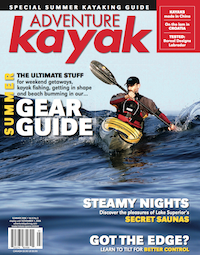The ability to comfortably and confidently edge your kayak is an important step to advanced paddling.
It’s also the key to tighter turns and improved boat control in challenging conditions. So on the next warm day, suit up for swimming, head to some warm water, and practice putting your boat on edge.
Edging is accomplished by dropping one knee and raising the other. Remember to keep your hips loose and your weight balanced over your kayak. Shift your weight slightly over to one butt cheek and lift the opposite knee. You should feel your whole rib cage shifting over to the “uphill” side of your kayak. Your stomach and side muscles will be working to keep your body upright, while your legs hold a steady tilt on the boat—particularly your top knee, which will be pulling upward on its thigh hook.
Your ultimate goal is to improve your balance and edge control to the point that you can take effective strokes while edging. A great drill to build this skill is to paddle forward in a straight line while holding your kayak on edge. Work on your right edge for about 10 strokes, then switch to the left edge. Keep practicing this drill, alternating from edge to edge until the transition becomes smooth and controlled.
You’ll quickly learn that edging your kayak will cause it to turn away from the direction that you’re tilting.
When paddling forward, if you edge to the left, your boat will turn to the right. Conversely, edging to the right will cause your kayak to veer left. The more you tilt, the more aggressively your kayak will turn. You can use this to your advantage, engaging your edge to make small course corrections without scrubbing forward speed or interrupting your forward stroke.
Edging is also very useful for keeping a kayak running straight. Wind, waves and current can all cause a boat to veer off course. Tilting a kayak on edge can help counteract the effects of prevailing conditions that are deflecting a boat in one direction, by encouraging the boat to turn in the opposite direction. One turn cancels out the other, keeping your boat moving in a straight line. It may be necessary to edge only for a few moments (as when crossing a line of current) or for an extended period (as when fighting a sustained wind).
With practice, you will find it easy to quickly edge your boat to either side, maintain it held on edge, and smoothly switch from one edge to the other. You’ll also be able to use your new edging skills to maneuver more efficiently and hold a course in challenging conditions.
Alex Matthews is the co-author of the book Touring and Sea Kayaking—The Essential Skills and Safety and the instructional DVD The Ultimate Guide to Sea Kayaking.
 This article first appeared in the Summer 2006 issue of Adventure Kayak Magazine. For more great content, subscribe to Adventure Kayak’s print and digital editions here.
This article first appeared in the Summer 2006 issue of Adventure Kayak Magazine. For more great content, subscribe to Adventure Kayak’s print and digital editions here.



